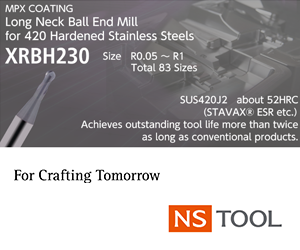Dear Doc: I have a 1970s-era, hydraulically driven surface grinder with a unique feed feature. As the table oscillates back and forth, the wheel feeds down at a constant feed rate. It seems this isn’t the most efficient way to grind, and we’re debating whether to modify it to do a rapid infeed at the end of each stroke. What’s your take?
The Doc Replies: I know that type of machine well and have twice recommended to clients to change this feed feature. In both cases, they were able to reduce cycle time without adversely impacting wheel wear or burn.

Courtesy of J. Badger
Figures a and b. Compared to a constant down feed with a maximum DOC of 0.002" (Figure a), an incremental down feed with a maximum DOC of 0.001" (Figure b) lowers the grinding temperature and reduces wheel wear while achieving the same cycle time. By increasing the maximum DOC to 0.002" when grinding at an incremental down feed, a user can cut cycle time in half while experiencing about the same amount of wheel wear and burn risk when grinding at a constant down feed with a maximum DOC of 0.002".
That’s because with the constant down feed, the DOC increases from near zero at the beginning of the pass to a DOC of, say, 0.002" (Figure a). In terms of burn and wear, the restricting factor is the DOC at the end of the stroke, or 0.002".
Now let’s look at incremental down feed (Figure b). If you increment 0.001" at the end of each stroke, you’ll reach the final position at the same time. However, the maximum DOC is only 0.001", not 0.002" as with constant down feed. That produces lower temperatures and less wheel wear. So now you can increase the DOC to 0.002" for each stroke and have about the same wheel wear and burn risk as when constantly down feeding at a maximum DOC of 0.002"—but cycle time is cut in half.
Dear Doc: I ID cylindrical grind very long, hollow parts, so the wheel sticks out on the shaft a long way, giving me lots of push-off. When I try to spark-out, it seems the wheel just rides over the part and I never get to final depth. Is there a way around this?
The Doc Replies: Yes, there are several things you can do. First, turn your coolant down to barely a trickle during spark-out. This will reduce the hydrodynamic forces that are causing the wheel to ride over the workpiece. This works with water-based emulsions, but it is a must-do with oil-based coolants.
Second, you need to get the abrasive grains to “bite” the workpiece during spark-out, not just to “tickle” the surface. You can do this by increasing the workpiece rpm and decreasing the wheel speed.
Finally, make sure you don’t have an “integer value.” Your wheel rpm divided by workpiece rpm should be something like 8.1295472—not 8.0000000. That way, any out-of-roundness in the wheel is not repeatedly imparted into the workpiece, but is obliterated during spark-out.
Related Glossary Terms
- abrasive
abrasive
Substance used for grinding, honing, lapping, superfinishing and polishing. Examples include garnet, emery, corundum, silicon carbide, cubic boron nitride and diamond in various grit sizes.
- coolant
coolant
Fluid that reduces temperature buildup at the tool/workpiece interface during machining. Normally takes the form of a liquid such as soluble or chemical mixtures (semisynthetic, synthetic) but can be pressurized air or other gas. Because of water’s ability to absorb great quantities of heat, it is widely used as a coolant and vehicle for various cutting compounds, with the water-to-compound ratio varying with the machining task. See cutting fluid; semisynthetic cutting fluid; soluble-oil cutting fluid; synthetic cutting fluid.
- feed
feed
Rate of change of position of the tool as a whole, relative to the workpiece while cutting.
- grinding
grinding
Machining operation in which material is removed from the workpiece by a powered abrasive wheel, stone, belt, paste, sheet, compound, slurry, etc. Takes various forms: surface grinding (creates flat and/or squared surfaces); cylindrical grinding (for external cylindrical and tapered shapes, fillets, undercuts, etc.); centerless grinding; chamfering; thread and form grinding; tool and cutter grinding; offhand grinding; lapping and polishing (grinding with extremely fine grits to create ultrasmooth surfaces); honing; and disc grinding.
- inner diameter ( ID)
inner diameter ( ID)
Dimension that defines the inside diameter of a cavity or hole. See OD, outer diameter.
- spark-out ( sparking out)
spark-out ( sparking out)
Grinding of a workpiece at the end of a grind cycle without engaging any further down feed. The grinding forces are allowed to subside with time, ensuring a precision surface.









